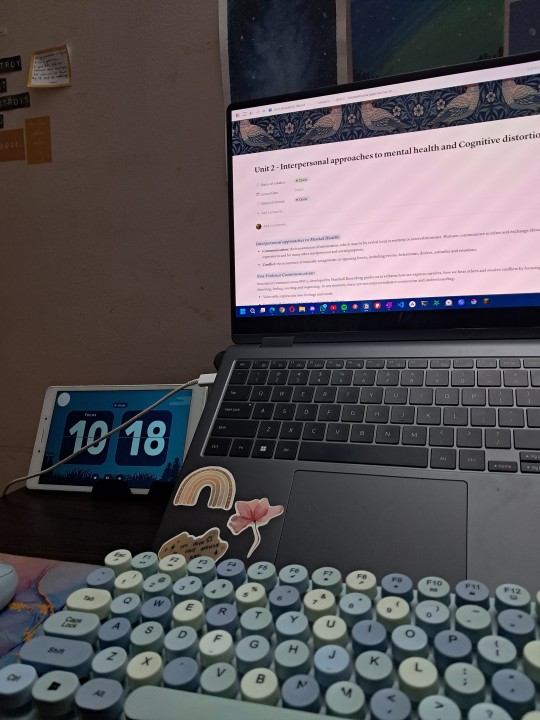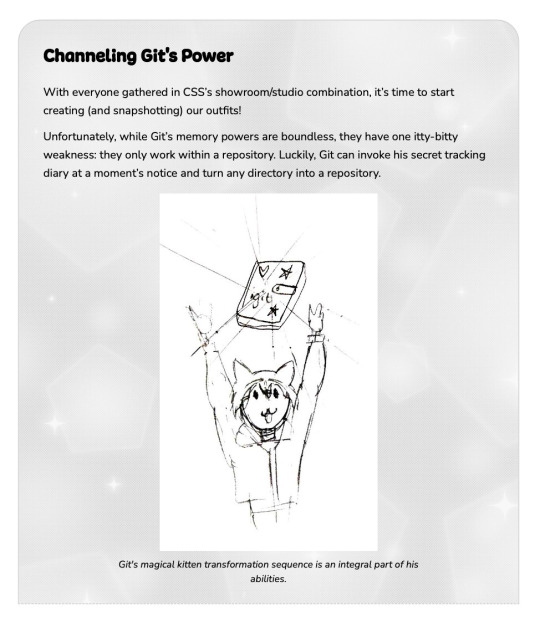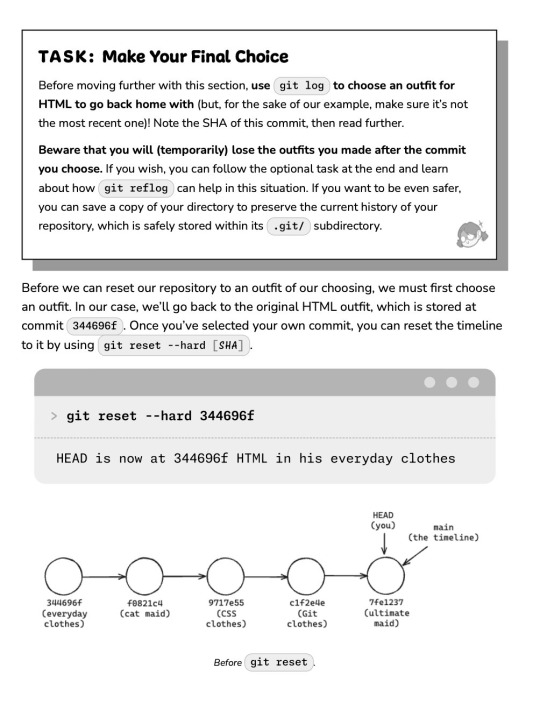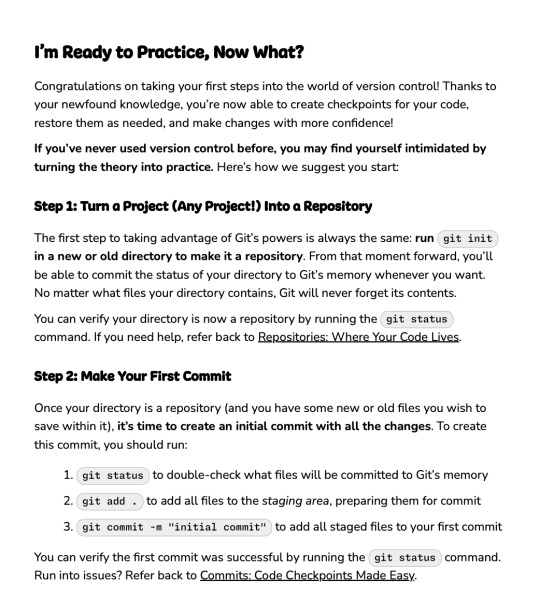#git for beginners
Explore tagged Tumblr posts
Text

Use Git if: ✅ You need speed and distributed development ✅ You want better branching and merging ✅ You work offline frequently
#git tutorial#git commands#git basics#git workflow#git repository#git commit#git push#git pull#git merge#git branch#git rebase#git clone#git fetch#git vs svn#git version control#git best practices#git for beginners#git advanced commands#git vs github#git stash#git log#git diff#git reset#git revert#gitignore#git troubleshooting#git workflow strategies#git for developers#cloudcusp.com#cloudcusp
1 note
·
View note
Text
How To Pick the Right Git and GitHub Course
Are you searching for a suitable Git and GitHub Course? If you are wondering where to find Git for beginners courses, you must check out a reliable platform that can guide you in the right direction. The right platform can provide various features and make your overall learning experience seamless and hassle-free. Let’s find out a few features that will make your learning journey unforgettable.
Accessible from mobile
No matter which GitHub for beginners course you choose, it should be easily accessible from your mobile phone. A lot of times, you may be stuck in a bus or train or just have some spare minutes at hand. In such a situation, you would want to revise your course quickly, and you may not have your laptop with you. So, with the help of a platform that helps you access the course using your mobile phone, things will become relatively easier. You can revise at any time you want.
Dark mode for long hours of study and practice
When studying for long hours, the white light can strain your eyes. So, the platform you choose for the GitHub course should have dark mode available. Using dark mode, you can study for several hours at a stretch as your eyes will not feel uncomfortable. No matter how much you want to practice at once, you can do so with dark mode.
Bookmark important information
Does it happen to you that you read something and think you would want to return to this information frequently? For this, you should only rely on a platform that has a bookmarking option. You can easily bookmark important information and details and come back to them when you are revising or have any doubts. This will save the hassle of going through everything just to find that one important detail.
Suitable for everyone
Are you a beginner who has just started their journey with Git and GitHub? Or are you a coder who does not have much information about Git and GitHub? Regardless of how much you know about it, you should find a course suitable for everyone so that you can grasp concepts easily without struggling with understanding certain terms or methods.
If you are searching for a GitHub tutorial for beginners, you must check out a platform that offers an exceptional learning experience.
To find a GitHub course, visit https://d-libro.com/
Original Source: https://bit.ly/492Ewty
1 note
·
View note
Text
looking at github has me genuinely sick to my stomach I KNOW the line endings are different I have been TRYING to FIX it for DAYS.
#why is this so hard#why does every result when I look this up assume that I know how to use git commands or whatever#this is my first time using this#is anybody out there#HOW has no github beginner asked online how to fix this like SURELY they've had to code in unity with someone who uses a mac.#How has no one else who doesn't know what the FUCK they are doing encountered this problem#polar.prattles#Two of my teammates have been doing literally fuck all. ITS DUE IN TWO DAYS???
6 notes
·
View notes
Text

Pov: You feed her too much Chocolate
@doyoureallyneedme @nightdustfallen She thanks all the hugs tho.
#shaibonbon#drawing#my art#shai sketch#shai oc#shai minibon#oc#shai shitpost#bunny girl#bunny#digital art#quick sketch#sketch art#she had too much Chocolate#no wonder she git fat as adult#no wonder she got fat as an adult#beginner drawing#beginner artist#art
15 notes
·
View notes
Text
electric guitar... electric guitar save me.......
#i just need to get enough money by the end of the year to buy an electric guitar that's IT#my big dream is actually to start a band. dead serious.#but i can't sing past a very small range (good screamer tho) no space for drums and don't want to play bass....#the electric guitar is simply the coolest instrument you see#anyway maybe i'll save and get a telecaster but idk the best beginner's guitar so#i'm continuing the tradition of my sisters getting into instruments and then never touching them again#for my oldest sister it was the violin for my other sister it was the acoustic#but this time i'll actually like practice daily and git gud at it PROMISE YOU THAT#and also i need money to buy cool outfits too... what's a guitarist without a cool outfit
15 notes
·
View notes
Video
youtube
🔍 Git Architecture | Understanding the Core of Version Control 🚀
Ever wondered how Git works behind the scenes? This video breaks down the core architecture of Git and how it efficiently tracks changes. Learn:
- 🏗 How Git Stores Data: The difference between snapshots and traditional versioning. - 🔀 Key Components: Working directory, staging area, and local repository explained. - 🌐 Distributed System: How Git enables collaboration without a central server. - 🔧 Commit & Branching Mechanism: Understanding how changes are managed and merged.
Master Git’s architecture and take full control of your code! 💡
👉 https://youtu.be/OHMe-H35xWs
🔔Subscribe & Stay Updated: Don't forget to subscribe and hit the bell icon to receive notifications and stay updated on our latest videos, tutorials & playlists! ClouDolus: https://www.youtube.com/@cloudolus ClouDolus AWS DevOps: https://www.youtube.com/@ClouDolusPro THANKS FOR BEING A PART OF ClouDolus! 🙌✨
#youtube#Git for DevOps GitHub for DevOps version control for DevOps Git commands for beginners GitHub Actions CI/CD DevOps tools CI/CD pipelines Git#What Is Git?What Is Git Core Features and Use Cases?What Is GitHub?What Is GitHub Core Features and Use Cases?What Is GitHub Actions?What Is#cloudolus#cloudoluspro
0 notes
Text
you should make a website!
"my favorite social media site is shutting down!"
"the CEO of the site i use just committed another atrocity!"
"i want a webspace that's all my own!"
if any of these sound like you (and if you're on tumblr, i know at least one applies) you should make your own website!
why make a website?
incredibly customizable
you can put whatever you want on it
it's, well, your own! like a house you build with your own hands
things you'll need
a computer. you can maybe get away with doing this on a mobile device, but i have zero experience there
a code editor. i like VScodium, which is a de-microsoft-ed version of VScode.
a will to learn ;)
site hosting
neocities. everyone knows neocities. at this point i do feel like it's become a bit too centralized, but it's a good option nonetheless. do note that there are filetype restrictions for free users, but that shouldn't be a huge issue for most. what may be an issue, though, is that there's a content security policy that prevents sites made after jan 1st, 2024 to use outside scripts. also, you have to pay to use your own domain
nekoweb. similar to neocities, but there's no filetype restrictions or a content security policy. some differences are outlined in the FAQ (thinking about moving here... i am a traitor...) i'm not sure if domain support is free or paid.
github pages or codeberg pages. you'll need an understanding of git for this
pages.gay: run by besties.house, uses git
teacake: free hosting is currently closed, but paid hosting starts at 2 bucks a month.
leprd.space: i know next to nothing about this.
a web server. don't recommend this if you don't know computer stuff but it is an option (you'll likely have to provide your own domain though)
gripes & solutions (?)
i'm not comfortable maintaining pages in pure HTML / templating with JS sucks!
with a static site generator, you can write pages in markdown and they'll be converted into HTML and (if you'd like) be put into a template of your choosing. my personal choice is 11ty but there are tons of options!
static site generators can be a bit of a learning curve (and you will have to write some html for templating) but if you're making a lot of pages or blogging regularly it's something to consider
there are starters for 11ty online but i might make a more beginner-proofed starter and/or guide in the future? don't count on it
i don't want to write/maintain CSS
simpleCSS is a tiny CSS file you can use to make semantic HTML ("naked" HTML) look nice. it's got decent customization options too. it's not particularly fancy or opinionated, but it's a good starting point if you need something
i don't know what to put on my website!
small list of ideas:
weblog
art/writing/music gallery
movie/show/book tracker
place to store bookmarks/links
scary! i'm scared!
my askbox/messages/e-mail inbox/etc. are open to anyone who'd like to ask for help!
418 notes
·
View notes
Text
Okay, I'll give it a shot; git is a program. You use it to make a git repository (which is in practice just a folder with some metadata).
The repository stores series of commits. Each commit stores a series of changes made since the previous one - files which have been added, files which have been removed, and changes which have been made to existing files.
(It stores them in branches, which have separate histories, but to begin with you'll just be dealing with one 'main' branch.)
You can then 'push' commits from this local repo to a remote repo, often on a service like GitHub, so the commit history can be shared between different devices, people, etc.
Doing any of this directly with git itself in the command line involves giving it a complicated series of commands in a specific order, often starting with the most complicated stuff before you can get to the simple stuff. In practice, you'll generally be using another program as a wrapper over git; which git client you use is mostly a matter of preference. On Windows good places to start could be the GitHub desktop client, which abstracts a lot of the more complicated bits away, or the default Git Gui which comes with Git for Windows, which maps more directly to whats happening on the command line (but with clearly laid out buttons instead of hard-to-memorise syntax). You shouldn't need to drop down to the command line until you're needing to do more complex stuff.
Start with the basics of getting something versioning, then you can work up into branches and all that if and when you need to. Each step is much easier once you've got a firm footing in the previous one.
Can someone explain to me in like five seconds how to use git, assuming that I know basic shit about coding/command line/whatever but don't know any of the specific terminology related to git. Like every tutorial online is at the same time both over my head and also vastly too basic. Just like. Tell me what it is.
Uh. First tell me its ontology. Is it a program, a standard, a language...? I know that it's for version control. Suppose I wanted to do version control at a piece of code. What do I do. What buttons do I press, on my computer? Tell me these things.
#git#does that work as an explanation? i've only been using this stuff for like a year idk if im at the point where i can properly re-explain it#also to clarify the difference between git and github:#git the program that represents the repos. it's like twenty years old and was originally made for tracking the development of linux#a git remote is just a git repo on a server somewhere#GitHub is a company that makes a business out of hosting servers with git repos on them. there are other ones too#(it's able to have git in its name since git comes from the linux world and so isn't under copyright in any form)#GitHub is the most popular one and is generally what you suggest to beginners since it lets you make both public and private repos for free#(you only have to pay when you need a private repo that multiple people can access)#(this business model is able to make sense because git repos take up a frankly ridiculously small amount of storage space)
476 notes
·
View notes
Text
Hello and welcome to today's instalment of "Harry doesn't know what he's feeling when he's feeling it". I'm in the middle of going through the books (for nerd reasons) and I stumbled upon this passage:

And the thing is: this happens in book 1, right at the beginning of the school year. Not only have Draco and Harry interacted very little so far but the inciting incident that made Harry react this way is peculiar.
You see, Harry here is thinking back on his first ever potions lesson, where Snape tried to humiliate him at every turn. In that scene Draco does not interact with Harry, all he does is be a gleeful spectator to the dressing down and also make potions. Literally.
Draco mentions in the scene:
The slytherin boys (or at the very least the ones Harry knows so far) are amused by Snape's roasting of Harry

2. second verse, same as the first

3. Draco is good at potions, this irritates Harry

That's literally everything. All Draco is guilty of here is being present for Harry's humiliation and being competent at something Harry is trying for the first time. Yes, he's laughing at Harry's misfortune but this is not described as a performance for his benefit (unlike in later books where Draco will make sure Harry sees him laughing at his misfortune). Harry sees Draco's reaction (and Crabbe and Goyle's) but are they the only ones laughing or are they the only ones Harry is paying attention to? Harry explicitly says, in the second passage I mentioned, that he tries not looking at Draco+ Crabbe&Goyle; this to me implies that he's especially conscious of them and their reaction.
As I remarked here about their very first interaction, Harry's feelings towards Draco are, from the get-go, more complicated and nebulous than one might think. If I had to name what sentiments Draco inspires in Harry in these first interactions, I'd say a non insignificant one is inadequacy.
We can see that during the first potions lesson, and again at the thought of a shared flying lesson, Harry very much dislikes the thought of being seen failing by Draco . Why, on Harry's very first night at Hogwarts he has a nightmare and you know who's featured prominently in it, witnessing Harry in an embarrassing situation and laughing about it? None other than Draco Lucius Malfoy.
I find this interesting because Harry claims his feelings towards Draco are similar to what he feels towards Dudley (at this point in the narrative he's remarked on it more than once) but Dudley's actions towards Harry are intentional (pre-Hogwarts dudders loves bullying Harry) whereas Draco has yet to do anything to Harry other than try really badly to befriend him (and be stung by his rejection).
Furthermore Harry, from what we see from his interactions with Dudley, does not seem to be at all self conscious of the way he behaves in front of his cousin nor does he measure his achievements by comparing them with Dudley's. I'd say his general attitude toward Dudley is dismissive, in complete contrast with the competitiveness he feels with Draco yet, somehow, Harry keeps associating the two in his mind.
There's this element of self-fulfilling prophecy in Harry and Draco's interactions (no doubt because jkr is telling us to dislike Draco before showing us why) that I never noticed before. Harry dislikes Draco at first sight (more accurately, he's unsettled by him and decide this means he dislikes him) so he's going to look for other things to dislike in order to reinforce his bias:
Draco receives packages from home? Wow, he's spoiled just like Dudley, nevermind the fact that countless other students are undoubtedly receiving just as many packages.
Draco is a competent beginner potions student? Oh wow, it's just like that git to succeed in a class taught by another git (essentially: if you're favoured by a bad person that means you're bad too)
And because these reactions don't happen in a vacuum, Draco notices them, which fuels HIS complicated emotions vis-à-vis Harry. Add all of this to the feelings of rejection he has no doubt been stewing on and voilà, you have the birth of Draco's decision to be Harry's enemy (since he can't be his friend).
tldr: Harry indadvertedly started the rivalry with Draco and Draco followed suit because negative attention is still attention.
#hp#drarry#hpdm#why I ship it: an illustrated compendium#I kinda read it as: Harry wants a relationship of equals#which is why he chooses to befriend Ron and not Draco#(11 y.o Draco knows nothing about how friendships work see: Crabbe&Goyle)#and you know who else you can have an equal relationship with?#your rival#Harry's desire not to be seen failing by Draco becomes wanting to win against him real quick#harry potter meta#the Blorger Special#the drarry of it all
260 notes
·
View notes
Text

December 14, 2024 • Saturday
Counting down until the new year: 17 days to go!
Today was. I don't know whether it was productive or unproductive. I started studying the amazing beginner's guide to git by @moose-mousse and now it's not longer intimidating! But then guests arrived and all my plans of studying psych notes and python went down the drain lolll. I need to complete them along with tomorrow's tasks ugh
🎧 MANIAC — Stray Kids

#dailyfoxposts#studyblr#studyblr tag#codeblr#studyspo#study#note taking#compblr#psychology#uni life#academia#uniblr#undergrad#student#study motivation#inspo
71 notes
·
View notes
Note
hi a friend walked me through a commander game and I liked it and so I got a couple premade decks. I then went to a couple commander nights and I kinda liked it except for the part where I felt like I was a little kid with floaties in the middle of the ocean trying to sing a little song to myself so I wouldn't think about the things that might be lurking just below the surface that I can't see. Magic is vast and deep and I don't know how I can enjoy playing when there's just too much. I get that the hugeness is part of its staying power, but it feels too big and too much to even approach beyond playing my premade deck and hoping the people at the table won't look down on me for it (which they often do). Even looking up tutorials and guides is overwhelming because each one of them is sharing a *different* tiny slice of material! I haven't felt this baby-beginner starting something new in a very long time (and I say that as someone that is otherwise well-versed in being a terrible beginner at new things). Is there a way to play magic without getting absolutely lost in the depths? or is that the nature of the beast and I just gotta "git gud"?
The two formats I would suggest are draft or Cube. Both use a much smaller card pool, one you can more easily learn about.
101 notes
·
View notes
Text
✨(G)IT'S DELIVERY DAY✨
The first issue of the Fujoshi Guide to Web Development has been drafted, edited, alpha-read, beta-read, possibly even omega-read—and starting today, it'll be backer-read!
After 18 months' work, the digital preview hit our backers' inboxes this morning.


As you can imagine, A LOT of work from A LOT of incredibly talented people went into making this day possible.
Our mission was not easy: creating an approachable and engaging learning experience for beginners with a technology as complex as Git? "Impossible!", many would say.
And yet, according to our beta readers, we succeeded in doing just that. So it's time for the penultimate test: put the digital preview in the hands of a slightly-broader public and find out if our backers agree with our betas!
As you can imagine, we're scared but excited 🫣




Thanking everyone who participated in this issue would fill the whole tweet, so here's the zine credits in the pics👇, featuring @essential-randomness, @enigmalea, @starfieldcanvas, @ymkse, @elendraug, @doubledeadstudio, @ikam177, @sgt-spank, @tarantasina, @a-brilliant-loser, @mappapapa and beyond!


Remember to sign up for our newsletter on to follow along with our progress, or sign up at the bottom of our site to get notified when Issue 1 is available to the general public!
And you can always get updates by following us here!
85 notes
·
View notes
Text
FINALLY got done with the Beginners guide to GIT
So a long time ago I made a poll to help me make a Begginers guide to GIT because a lot of people seem to have trouble with it. https://www.tumblr.com/moose-mousse/722172571753365504/going-to-make-a-getting-started-with-git-post?source=share
And I know for a fact that my University taught it horribly. (Or rather... did not teach it at all)
I REALLY tried making this guide as short as I possibly could. Explaining only what you need to know, while trying to clarify what most people find confusing. But it still is too long for a single post. So, I have split it into 5. The post each links to each other, so you should be able to go back and forth easily.
This guide is going to be pure GIT done via the command line. 2 reasons for this:
1: GIT GUI’s are really handy, but they abstracts away a lot of the newbie help GIT is trying to give you. Bitbucket, Github, Jira, and other services use GIT but usually add extra bits that are specific to them. So to know how they are different, it is smartest to learn pure GIT first. And since they are 99% GIT, you will be able to use them with no/little trouble.
2: Because I use the command line, it is easy to build your own automation tools. Simply have a program write git commands to the shell and/or read outputs from git commands and use them to visualize whatever you want, however you want. That way you can have whatever shiney graphics your heart can code up. All the tools you can find (Like Github desktop or gitk) are simply doing this. (incidentally, if any of you make a pretty visualization of GIT? Show me! I wanna see a dog themed GIT graph! I wanna see pink log outputs! Make it yours!)
Table of content: Part 1: What is GIT? Why should I care?
Part 2: Definitions of terms and concepts
Part 3: How to learn GIT after (or instead of ) this guide.
Part 4: How to use GIT as 1 person
Part 5: How to use GIT as a group.
146 notes
·
View notes
Text
here's a list of all the intermediate coding tutorials i've written so far!
git / github tutorial
npm (and node.js) tutorial (+ how to use the command line) (this one's a prerequisite for the following 2 tutorials)
webpack tutorial (a module builder for JavaScript and (S)CSS)
11ty (eleventy) tutorial (a super easy static site generator!)
if you have ideas/requests, feel free to contact me!
more beginner coding tutorials are coming VERY soon! meanwhile, check out my common questions and common mistakes pages!
#web development#coding#coding tutorials#neocities#git tutorial#npm tutorial#webpack tutorial#eleventy tutorial#static site generator#coding tutorial#git#github#npm#webpack#eleventy#11ty
20 notes
·
View notes
Text
Tips for New Web Developers: Building a Strong Foundation
Tips for New Web Developers: Building a Strong Foundation
As a beginner in web development, it's important to focus on the fundamentals before diving into complex projects. Here are a few key tips to help you build a strong foundation:
Learn HTML & CSS: These are the building blocks of web development. Mastering them will allow you to create basic, functional websites.
Understand JavaScript: This language brings your websites to life by enabling interactivity. Start small and work your way up to more advanced concepts.
Responsive Design: Ensure your website looks great on all devices by learning responsive web design principles. Mobile-first design is crucial today.
Version Control (Git): Use Git for tracking changes to your code and collaborating with others. GitHub is a great platform to showcase your projects.
Focus on Clean Code: Write clean, readable code that is easy to maintain. It’ll help you and your future collaborators down the line.
Remember, the journey may be challenging, but with consistency and practice, you’ll become proficient and confident in web development. Keep coding! 🚀
#design#etsy#html#technology#website#web design#web developers#web development#html css#html5#htmltemplate#htmlcoding#frontenddevelopment#code
4 notes
·
View notes
Text
How to Build Software Projects for Beginners

Building software projects is one of the best ways to learn programming and gain practical experience. Whether you want to enhance your resume or simply enjoy coding, starting your own project can be incredibly rewarding. Here’s a step-by-step guide to help you get started.
1. Choose Your Project Idea
Select a project that interests you and is appropriate for your skill level. Here are some ideas:
To-do list application
Personal blog or portfolio website
Weather app using a public API
Simple game (like Tic-Tac-Toe)
2. Define the Scope
Outline what features you want in your project. Start small and focus on the minimum viable product (MVP) — the simplest version of your idea that is still functional. You can always add more features later!
3. Choose the Right Tools and Technologies
Based on your project, choose the appropriate programming languages, frameworks, and tools:
Web Development: HTML, CSS, JavaScript, React, or Django
Mobile Development: Flutter, React Native, or native languages (Java/Kotlin for Android, Swift for iOS)
Game Development: Unity (C#), Godot (GDScript), or Pygame (Python)
4. Set Up Your Development Environment
Install the necessary software and tools:
Code editor (e.g., Visual Studio Code, Atom, or Sublime Text)
Version control (e.g., Git and GitHub for collaboration and backup)
Frameworks and libraries (install via package managers like npm, pip, or gems)
5. Break Down the Project into Tasks
Divide your project into smaller, manageable tasks. Create a to-do list or use project management tools like Trello or Asana to keep track of your progress.
6. Start Coding!
Begin with the core functionality of your project. Don’t worry about perfection at this stage. Focus on getting your code to work, and remember to:
Write clean, readable code
Test your code frequently
Commit your changes regularly using Git
7. Test and Debug
Once you have a working version, thoroughly test it. Look for bugs and fix any issues you encounter. Testing ensures your software functions correctly and provides a better user experience.
8. Seek Feedback
Share your project with friends, family, or online communities. Feedback can provide valuable insights and suggestions for improvement. Consider platforms like GitHub to showcase your work and get input from other developers.
9. Iterate and Improve
Based on feedback, make improvements and add new features. Software development is an iterative process, so don’t hesitate to refine your project continuously.
10. Document Your Work
Write documentation for your project. Include instructions on how to set it up, use it, and contribute. Good documentation helps others understand your project and can attract potential collaborators.
Conclusion
Building software projects is a fantastic way to learn and grow as a developer. Follow these steps, stay persistent, and enjoy the process. Remember, every project is a learning experience that will enhance your skills and confidence!
3 notes
·
View notes